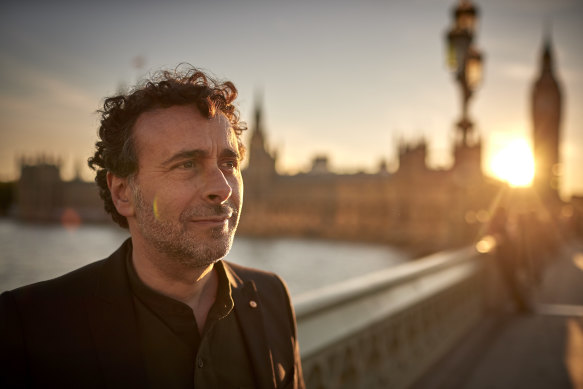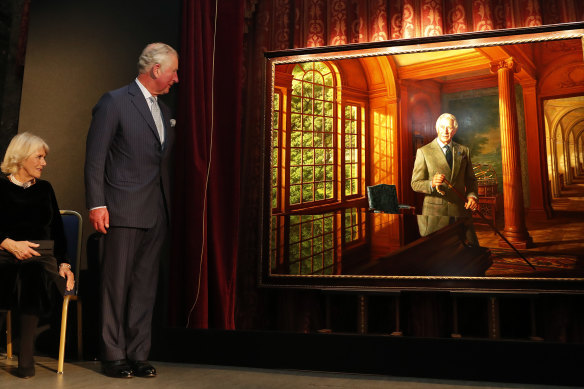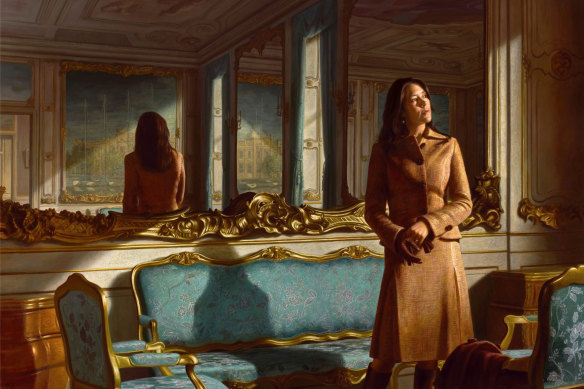The little-known Australian treasure inside Westminster Abbey

London: As 2000 mourners gather in Westminster Abbey for Queen Elizabeth II’s state funeral on Monday, high above them hangs the largest-ever portrait of the monarch – painted by an Australian.
“People say it forms part of the fabric of the abbey … I couldn’t have dreamt of a better outcome for the painting,” says artist Ralph Heimans, who was granted an hour-long sitting with the Queen in the Yellow Drawing Room of Buckingham Palace in 2012.
Sydney-based Heimans was given 10 days to prepare his ideas for the majestic portrait commissioned to celebrate her 60 years on the throne.
Artist Ralph Heimans photographed outside the Palace of Westminster in London, England ahead of the Queen’s state funeral.Credit:Kiran Ridley
“It was a huge gamble for me,” he says.
The stakes of painting the world’s most recognisable woman inevitably came with visceral nerves and material costs.
“I took out four loans,” he recalls. “My wife and I literally bet everything we had for this portrait.”
Ralph Heimans’, The Coronation Theatre: Her Majesty Queen Elizabeth II, 2012, oil on canvas. At 2.5 metres high by 3.4 metres wide, it is the largest portrait of the Queen.Credit:Westminster Abbey Collection
Six years earlier, Heimans painted the Crown Princess Mary of Denmark shortly after her wedding to Crown Prince Frederik.
The work showcased his ability to highlight the unique lives of his subjects and served as a precursor to his next royal portrait: Queen Elizabeth II.
The Coronation Theatre – the name given to the official Diamond Jubilee portrait – is now part of the Royal Collection and housed in the coronation and burial site of some of Britain’s most famous kings and queens.
Capturing the intersection between free will and sacrifice has become a hallmark of Heimans’ royal portraits.
The Queen’s portrait led to two more commissions from the British royal family: the new King when he was the Prince of Wales and Prince Philip in what would be the duke’s final portrait before his death in 2021.
“The tension, the sense of duty but also the burden is what fascinates me as an artist,” he says.
Heimans says the decision to portray the Queen at Westminster Abbey was a nod to her 60-year reign but also enabled him to explore a narrative he believed would engage the public.
“It was about returning to the point of origin where the Queen’s story began,” he says, referring to her coronation at the age of 26, one year after King George VI’s death.
Charles and Camilla unveil Ralph Heimans’ portrait of the future king during a ceremony at Australia House in London in 2018.Credit:AP
“The darkness of the abbey and all that space surrounding her was to accentuate her singular experience and how she stayed true to the oath she made.”
Her head is bowed and there’s a pensive expression on her face. Behind her are the choir stalls, representing where the heads of Commonwealth normally sit.
“I wanted to express how difficult and isolating and lonely it was in some ways.”
The Queen’s interest in the project and her hands-on approach came to light in the weeks leading up to the sitting. “Every idea had to be passed by her,” he says.
An initial request for the monarch to wear her purple coronation robe for the sitting was placed on hold because the Queen wanted to speak to her husband before signing off.
“The tension, the sense of duty but also the burden is what fascinates me as an artist.”
“The decision came back that she would wear the Robe of State which she has worn every year for the opening of parliament,” says Heimans.
Following the unveiling of the portrait, there was a common thread in the comments from those who knew the Queen. They said he’d captured “some sort of private essence” rarely seen in public.
“That’s an expression I’ve seen on the face of the Queen when she’s in prayer in the abbey,” John Hall, the Dean of Westminster Abbey told him.
Heimans’ portrait of Princess Mary helped introduce the Tasmanian-born royal to Denmark.Credit:Museum of National History
As the Queen is finally laid to rest at Windsor Castle, the celebrated portrait will become the closest thing to feeling as if you’re in her presence. “It’s extraordinary to think that it will have prominence and visibility to the public for a very long time,” says Heimans.
Get a note directly from our foreign correspondents on what’s making headlines around the world. Sign up for the weekly What in the World newsletter here.
Most Viewed in World
From our partners
Source: Read Full Article



